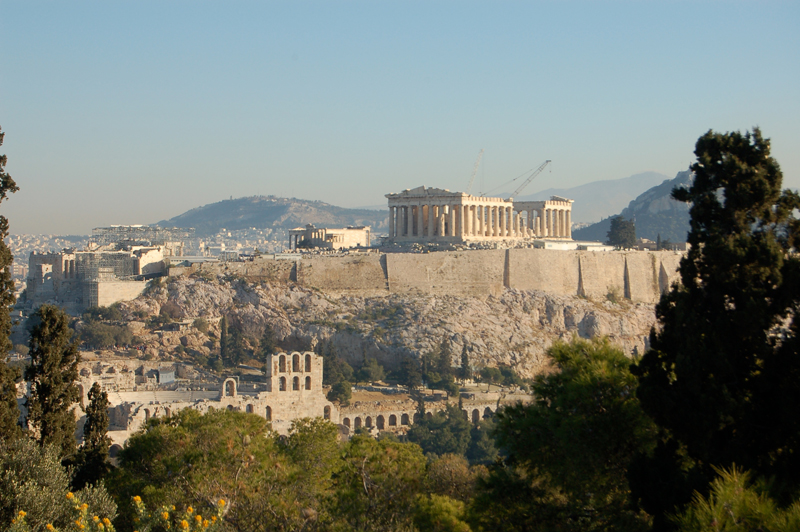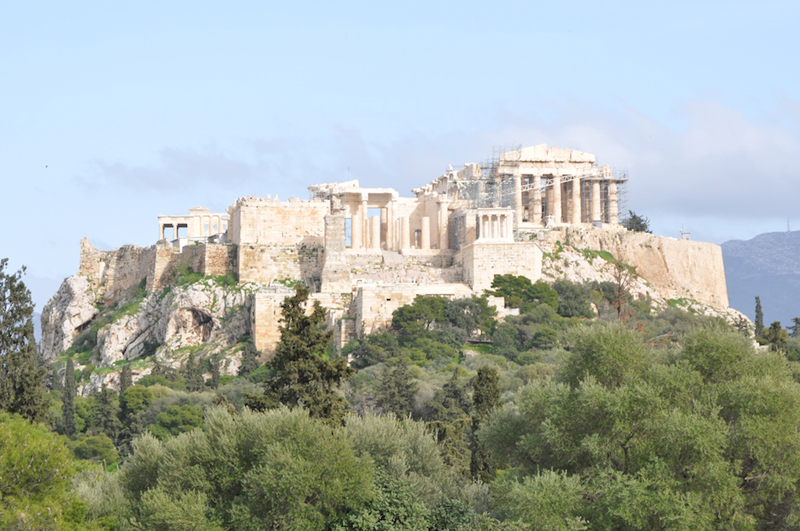Mark Stansbury-O’Donnell is completing a book on the history of Greek art that will be published by Wiley-Blackwell in summer 2014. This entry recounts one of the projects for the book during his trip to Athens in Feb. 2013.
When art historians get pictures to illustrate their research and work, we often rely on photographs that provide the best view of an object or building. For vases in museums, this usually means a straight profile shot showing the shape of the object and its decoration with as much focal depth as possible. Buildings are a bit harder since they have multiple sides and being taller than the average person, harder to see in their entirety unless you have an elevated view. For photographing the Parthenon in Athens, for example, many pictures are made from the Hill of Philopappos to south and west of the Acropolis. From here, one has a clear view of the elevation of the west and south sides of the Parthenon. One can also see the Erechtheion in its entirety, including the Caryatid porch, and, when not covered with scaffolding for restoration, the Propylaia and the Temple of Athena Nike. From this vantage point, the entire Periklean program of Classical Athens is clear to see.
The problem is that this vantage point is one that very few people, today or in the past, visited. It is a high spot visible from the rest of the city, which is why the Roman Gaius Julius Antiochus Philopappos built an elaborate monument there that can be seen throughout Athens. It was a place to be seen, but not to look from.
In writing my book, I have tried to emphasize the experience of the ancient viewer, and this means reconsidering what the ancient viewer could actually see. Shots like the first picture do not reflect a typical Athenian point of view. There is a place just to the north, however, that was a common vantage point for ancient Athenians: the Pynx. Today, this is a site that is little visited, mostly because it is just a large open bowl on a hill due west of the Acropolis. It is important, however, as the place where the ekklesia, the body of 6000 citizens who voted met as the Assembly of democratic fifth-century Athens. Here they heard speeches and made political decisions, voting on war, peace, public projects, and laws, among other things.
From the Pynx, one has a very different view of the Acropolis and Parthenon. Looking east from the Pynx, one sees full on the gateway of the Propylaia and the Temple of Athena Nike (victory), clearly an important factor in decisions on war. The Parthenon spreads out to the right and to the left the north porch of the Erechtheion, where the most important cults like the sacred olive tree of Athena were housed. From this view on the Pynx, one cannot see the buildings individually as an art historian would look at them for an analysis, but one would see them as Athenians were used to seeing them, while they were carrying out one of their most important roles as citizens. Undoubtedly, this was one goal for the Periklean building program, to make, as Perikles said, the citizens of Athens look upon their city and become lovers of that city.
I realized after I had written about this in several different chapters that I myself did not have a good photograph of the Acropolis from the Pynx. My photos were either too blurry or hazy or cloudy to use for publication, and that was true of some other photos I had that were made from the point of view of the Athenian rather than the art historian. In February, I had to spend several days in different parts of the city, working around the weather, to get the six or seven good photos that I needed for the book. Of course, the Parthenon now has a giant crane on rails in front of it as they work on restoring the building, but that is good for another point in the book, the preservation of the past.

